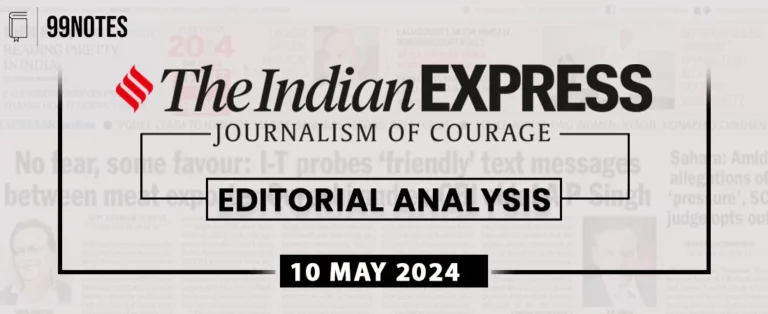2 April 2024 : Indian Express Editorial Analysis
Indian Express Editorial Analysis
2-April-2024
1. The choice before EC
|
Topic: GS2 – Polity – Constitutional Bodies This topic is relevant for both Prelims and Mains in the context of understanding the principles underlying democratic elections, including the importance of LPF. |
| Context: |
|
Importance of LPF in Democratic Elections
- The concept of LPF is crucial in democratic elections as it ensures that all political parties and candidates have an equal opportunity to compete for the voters’ mandate.
- Unlike in sports or warfare, where unequal matchups are often accepted, democratic elections require a fair and equitable environment for all participants.
- LPF upholds the integrity of the electoral process and fosters trust among voters.
Application of LPF in Elections
- LPF ensures that despite inherent inequalities among contestants, efforts are made to maintain fairness.
- While political parties and candidates may have varying strengths and resources, it is the responsibility of the election regulator, such as the EC, to enforce rules and guidelines that promote fairness.
- LPF is particularly focused on preventing the ruling party from gaining undue advantage over opposition candidates.
Role of the Model Code of Conduct (MCC)
- The MCC serves as a set of guidelines that political parties and candidates voluntarily agree to follow during elections.
- It covers various aspects of electoral behavior, including campaigning, conduct during rallies, and use of government resources.
- One of its key provisions is to prevent the ruling party from misusing its position for electoral gain.
- The MCC evolves over time to adapt to changing circumstances and ensure the integrity of the electoral process.
Challenges and Considerations for the Election Commission
- The EC faces the challenge of balancing adherence to established rules with the need to address emerging issues that may affect LPF.
- In cases where government agencies misuse their authority for electoral purposes, the EC must intervene to uphold democratic principles.
- This dilemma highlights the broader responsibility of the EC to ensure free and fair elections, as mandated by the Constitution.
Conclusion:
- LPF is a fundamental principle in democratic elections, upheld through mechanisms like the MCC and overseen by election regulators like the EC.
- As elections evolve and new challenges emerge, it is essential for the EC to adapt its approach to maintain the integrity of the electoral process and uphold the spirit of fairness.
| Impact of the Model Code of Conduct on Development and Governance |
|
As there are restrictions on the working of the ruling governments when the MCC is in place, there is a debate whether it impedes the governance of state as-
|
| PYQ: Discuss the role of the Election Commission of India in the light of the evolution of the Model Code of Conduct. (UPSC CSE (M) GS-2 2022) |
| Practice Question: Examine the significance of maintaining a level playing field (LPF) in democratic elections, with specific reference to the Indian electoral process. Discuss the role of regulatory mechanisms such as the Model Code of Conduct (MCC) in ensuring fairness and integrity during elections. (250 words/15 m) |
2. The importance of hope
| Topic: GS1 – Society – Population and associated issues This topic is relevant for both Prelims and Mains in the context of understanding the topic of shifting demographic trends and declining fertility rates and their implications which are essential for comprehending the socio-economic landscape of India and the world. |
| Context: |
|
Implications of Population Decline:
- While many may not live to witness this demographic shift, it raises concerns about the potential implications for society.
- With the decline in birth rates, the population is expected to age significantly, posing challenges in terms of support for older individuals and the allocation of health and social care resources.
- Neighbourhoods may transition from vibrant hubs of youthful activity to quieter spaces dominated by an aging population, reflecting broader societal changes.
Exploring Causes of Declining Fertility:
- Several theories attempt to explain the decline in fertility rates, including factors such as education, women’s empowerment, and changes in family structure.
- However, these theories fail to fully account for the significant decline in birth rates, particularly among wealthier segments of the population.
- There is growing evidence to suggest that young people are intentionally choosing not to have children due to concerns about the state of the world, including existential threats such as climate change.
Socioeconomic Challenges in India:
- In India, numerous socioeconomic challenges, including high levels of informal employment, income inequality, and declining happiness indices, contribute to an environment of uncertainty.
- Reports highlight widespread discontent among the youth, reflecting broader societal issues such as wealth concentration and democratic backsliding.
- In such a bleak scenario, the prospect of starting a family becomes increasingly unappealing.
Policy Imperatives:
- While demographic changes may seem inevitable, proactive policy measures can mitigate their impact.
- Policies promoting women’s education and addressing socioeconomic disparities are crucial in stabilizing fertility rates.
- However, more immediate interventions are needed to harness India’s demographic dividend effectively.
- Policies aimed at restoring hope among young people, bolstering labor and social security, and promoting inclusive and compassionate governance are essential in shaping a hopeful future.
Towards a Hopeful Future:
- A hopeful future lies in creating a more equal and compassionate society, characterized by progressive taxation, robust social security measures, and universal health coverage.
- Embracing diversity, fostering civil discourse, and safeguarding democratic principles are vital in shaping a future that prioritizes the well-being and dignity of all citizens.
- Ultimately, the choices made today will shape the trajectory of future generations, underscoring the importance of informed and decisive action.
| What are the consequences of declining fertility rate? |
| 1) Increase in aged population– By 2050, over 20% of India’s population will be senior citizens, it poses challenges related to care, support, and health care. 2) Shrinking Workforce– A smaller working age population could lead to labour shortages and affect economic growth. For ex- working-age population of China had contracted by more than 40 million. 3) Endanger Demographic Dividend– Experiences of developed nations suggests that once fertility rates fall below the replacement rate, it’s almost impossible to set them back.
|
| PYQ: Empowering women is the key to control population growth”. Discuss (150 words/10m) (UPSC CSE (M) GS-1 2019) |
| Practice Question: Examine the shifting demographic trends globally, with a specific focus on declining fertility rates and their implications for society. Analyze the socioeconomic challenges associated with these trends, particularly in the Indian context, and discuss the potential policy interventions to address them effectively. (250 words/15 m) |
For Enquiry

2 April 2024 : Indian Express Editorial Analysis

1 April 2024 : Daily Answer Writing

1 April 2024 : Daily Current Affairs Quiz

1 April 2024 : Daily Current Affairs

1 April 2024 : The Hindu Editorial Notes PDF

1 April 2024 : PIB Summary for UPSC

1 April 2024 : Indian Express Editorial Analysis

30 Mar 2024 : Daily Answer Writing

30 Mar 2024 : Daily Current Affairs Quiz

30 March 2024 : Daily Current Affairs
April 2024 Indian Express 2 April 2024 : Indian Express Editorial Analysis Indian Express Editorial Analysis
1-April-2024
1. Viksit must be inclusive
Topic: GS3 – Agriculture
This…
mains answer writing 1 April 2024 : Daily Answer Writing Mains Answer Writing
1-April-2024
Q1) A multi-faceted relationship between India and Africa has the…
Daily Quiz 1 April 2024 : Daily Current Affairs Quiz 1 April 2024 : Daily Quiz…
April 2024 Daily Current Affairs 1 April 2024 : Daily Current Affairs Daily Current Affairs
1-April -2024- Top News of the Day
1. Genetic profiling of captive jumbos of Kerala…
April 2024 The Hindu Editorial 1 April 2024 : The Hindu Editorial Notes PDF The Hindu EDITORIAL
1-April-2024
1. The Finance Commission and public finance in Kerala.
Topic:…
April 2024 PIB 1 April 2024 : PIB Summary for UPSC PIB Summary for UPSC
1-April-2024
1. CLOSING CEREMONY – EX TIGER TRIUMPH 2024
Topic: GS2 –…
April 2024 Indian Express 1 April 2024 : Indian Express Editorial Analysis Indian Express Editorial Analysis
1-April-2024
1. Viksit must be inclusive
Topic: GS3 – Agriculture
This…
mains answer writing 30 Mar 2024 : Daily Answer Writing Mains Answer Writing
30-March-2024
Q1) Sustained decline in maternal mortality rate (MMR) requires public…
Daily Quiz 30 Mar 2024 : Daily Current Affairs Quiz 30 Mar 2024 : Daily Quiz…
Daily Current Affairs 30 March 2024 : Daily Current Affairs Daily Current Affairs
30-March -2024- Top News of the Day
1. Indian Banking Sector Sees Continued Improvement…



